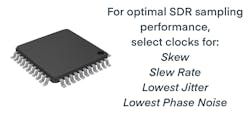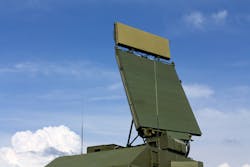What’s on Tap for Software-Defined Radio in 2022?
This article is part of the 2022 Microwaves & RF Forecast issue.
What you’ll learn:
- Sampling rates for data converters are on the rise, bringing multiple benefits to users.
- Higher data throughput is required to accommodate the rate of raw RF data capture and storage.
- Dealing with supply-chain issues requires careful planning.
We at Per Vices can't speak for the entire software-defined radio (SDR) community, but in this article, we will discuss our expectations for SDR in 2022. In terms of technological advances, the major focal points will be on increasing sample rates, along with overall system design to handle data flows up to 5 GS/s, and in general, continually extracting away more complexity associated with the hardware.
One of the more unexpected outcomes from the pandemic is the component shortages impacting many supply chains. This is especially true for electronic products, where government pandemic control mandates have simultaneously seen increased demand from people and companies switching to remote work, and limited production and distribution capabilities at many component manufacturers.
While they have caused a host of problems for many companies, Per Vices has taken several steps to ensure supply-chain continuity and continue delivering products to customers.
Higher Converter Sample Rates
Sample rate or conversion speed is a key metric of analog-to-digital converter (ADC) and digital-to-analog converter (DAC) performance capabilities. Improving converter bandwidth usually means increasing sampling rate. However, this is just the beginning, as our high-performance receiver chains use multiple ADCs, with each converter’s complementary clock solution dictating the dynamic range and capacity of the SDR system’s potential.
Fine-tuning these clocks for skew, slew rate, and the lowest possible jitter and phase noise are all clocking characteristics of utmost importance for optimal SDR sampling performance (Fig. 1). Moreover, optimizing for these higher sample rates often requires JESD204B or JESD204C links with the appropriate parameters for our specific frequency plan.
On top of that, implementing all this to work with our field-programmable gate array (FPGA), which performs decimation, filtering, and various other DSP for digital downconversion (DDC), also requires considerable engineering work. This, and more, are all part of the design process with increasing ADC sample rates to the 5-GS/s range.
Similarly, using DACs with high sample conversion rates allows for our transmit functionality to reap all of the benefits. What makes RF-sampling DACs remarkable is that they can include multiple DSP paths and integrate digital interpolation, numerically controlled oscillators (NCOs), and mixing to upconvert low-frequency signals to RF frequencies for transmitting over our wide tuning range and high instantaneous RF bandwidth. During development, these DACs require fine-tuning, such as gain, phase adjustment, and I/Q offsetting, to compensate for various issues.
In our SDRs, we also rely on other FPGA-based DSP before the signal reaches the DAC to sustain our high RF bandwidth. Understanding how these RF DACs work with the FPGA for digital upconversion (DUC) is just some of the development required to achieve higher sample rates.
Implementing faster sample rates at the converter brings multiple benefits to users of our SDRs. For one, oversampling will provide a higher effective number of bits (ENOB), up to the limits of the spurious-free dynamic range (SFDR) of the ADC. Moreover, by having a faster ADC sampling rate (Fs), the Nyquist zone or folding frequency regions (..., -Fs/2, -Fs, 0, Fs/2, Fs, 3Fs/2, 2Fs, ….) will increase such that the input signal band can be placed in the spectrum whereby all low-order harmonics from input band interferers/spurious signals will fall out of band. For higher-sampling-rate DACs, these ease filter design, place the signal on high IF or RF directly, and push the spurious image far away from the desired RF signal being transmitted.
Ramp Up in Data Throughput
Related to increases in converter sample rates are data-throughput advances. Of particular importance is ensuring that we can send and receive data packets, containing our complex-valued IQ data, at this sustained sample rate. Support for this capability requires a great deal of FPGA development, particularly in getting IP cores to packetize data for sending over quad small form factor pluggable plus (QSFP+) optical Ethernet transceivers.
Also related to data-throughput advances is building host systems that can handle massive amounts of data. Host systems built by Per Vices are fully designed to work with our SDRs. They’re optimized for the highest read/write when capturing data and are able to send and sustain super-fast rates over the network interface cards (NICs) and QSFP+ Ethernet connections.
Such systems contain high-speed NVMe drives (up to 40 TB), RAM (up to 2 TB), bulk storage (up to 100 TB), high-speed NICs (40GBASE-R or 100GBASE-R), GPUs, and all of the required adapters. For these systems to optimally stream the number of data packets, a variety of development occurs—for example, a data-plane development toolkit (DPDK) is implemented so that TCP packet processing can run in the user space of multiple-core CPUs. Such offloading allows for greater computer efficiency and higher data-packet throughput than is possible using the interrupt- or scalar-type processing provided in the kernel.
Host systems that are custom-built, pre-configured, and offer extendable future capabilities, in addition to a host of sample application programs, are just some ways we’re making it easier to integrate our SDRs and interfacing equipment into various systems.
So why is there a need for higher data throughput? Much like many industries generating astronomical amounts of data, the rate of RF raw data capture and storage is increasing as new RF applications become possible. This includes applications such as ultrawideband spectrum monitoring and recording for military users, to new use cases such as spectrum enforcement in current and future mobile networks.
Moreover, for other applications such as phased-array/MIMO antennas in radar and mobile networks (Fig. 2), the need to transmit wider-bandwidth signals is becoming crucial, particularly due to the complexity and size of the waveform data and sophisticated timing/triggering commands.
Extracting Hardware Complexity
The gist of the foregoing is that we build entire SDR systems that can be seamlessly integrated into new or legacy RF systems. Whether this is a radar, medical, GPS/GNSS, spectrum-monitoring application, or you name it, our goal is to deliver a product that works “out-of-the-box.”
We strive to ensure that users can work with our SDRs intuitively without needing expertise in fine-tuning, worrying about spurious signals in the spectrum, or being concerned about configuring a host system to work with our SDRs. We simply want users to be able to accomplish what they need to do without being bogged down by unnecessary details and complexity.
Anticipating IC Supply Shortages
For many other hardware companies, issues related to supply-chain shortages are fast becoming a problem, particularly with respect to integrated circuits (ICs). The first trigger in the chain of events causing IC shortages was the worldwide shutdowns in March 2020. This disruption led to widespread semiconductor fabs stopping all production. In addition, corporate IC customers adjusted orders from IC manufacturers based on how they thought the economic turbulence would affect their businesses.
For some, such as the automotive industry, scaling back IC orders was the norm as they anticipated slow automotive-sector growth. Conversely, consumer electronics companies foresaw growth opportunities for many of their products as millions were forced to stay home.
However, the automotive industry’s forecasting proved to be wrong, as consumer demand increased for vehicles, but supply was not there. This caused automotive industries to purchase IC chips used in vehicles to keep up with demand. This further exacerbated the scarcity of IC chips.
Other chains of events that continually impact IC fabs are shutdowns of ports in Asia, North America, and Europe. This leads to IC devices and chips sitting idle on ships and in containers, unable to reach their destinations. Moreover, many semiconductor foundries, particularly in Taiwan and China where the bulk of production takes place, have been impacted by storms and drought, causing shortages in the ultra-pure water required in these facilities.
Unfortunately, for the industry, these SDR advances will require some IC-based COTS components and chips that are in short supply. This includes all of the amplifiers we use, from low-noise amplifiers (LNAs) to gain block amplifiers. Other components such as FPGAs, CPUs/GPUs, ADC/DACs, RAM, etc., are in short supply. In general, it’s particularly hard to get components that are built using ICs, let alone them becoming more expensive.
Overcoming The Challenges
Per Vices seeks to mitigate these supply-chain challenges and continues to work to minimize impacts to timelines and costs. For one, we ensure full transparency with customers on these challenges and their potential effect on timelines. Similarly, minimizing price increases associated with the costs of all aspects of the product (not only are electronic component costs increasing, but so are the PCB fabrication, component assembly, and mechanical components of the products) is necessary to ensure our product prices remain stable and competitive.
Other ways include developing alternative circuit designs to accommodate components in stock or with a shorter lead time. This involves engineering time for the redesign as well as the rigorous design checks and reviews, simulation, validation, and final testing to ensure all changes still meet our high performance and quality requirements. Unfortunately, it’s not always as easy as drop-in replacements (i.e., footprint and pin-compatible) and sometimes it means redesigning for components exceeding the requirements at an additional cost that we absorb.
We can sometimes work within our own supply chain to source components from other authorized distributors that may have stock, or directly from the manufacturers. For orders that are already placed, we’re also working closely to help expedite those orders by increasing or decreasing the quantity (whichever works better for the manufacturer to handle and expedite).
For instance, sometimes it’s easier to ship a partial order (i.e., reducing the quantity), and other times it’s easier for the manufacturers to run a specific component line ahead of others if there are enough that warrant such a business decision (i.e., increasing the quantities). Accepting that orders placed are non-cancellable and non-returnable entails an increased risk to us without passing the risk on to our customers.
Of course, having recognized the possibility of global shortages when the pandemic began, we stocked up on materials, chips, and other components, along with having several of our SDR products available. Furthermore, we continue to forecast customer demand to alleviate future disruptions as this now requires planning out 12 to 18 months in advance, compared to previous forecasts that typically only required 3 to 6 months.
Read more articles in the 2022 Microwaves & RF Forecast issue.
About the Author
Brendon McHugh
Field Application Engineer & Technical Writer, Per Vices Corp.
Brendon McHugh is a field application engineer and technical writer at Per Vices, which has extensive experience in developing, building, and integrating software-defined radios. Brendon is responsible for assisting current and prospective clients in configuring the right SDR solutions for their unique needs. He holds a degree in theoretical and mathematical physics from the University of Toronto.


